Hardware
NZXT HUE 2 RGB Lighting Kit and AER RGB 2 Fans Review
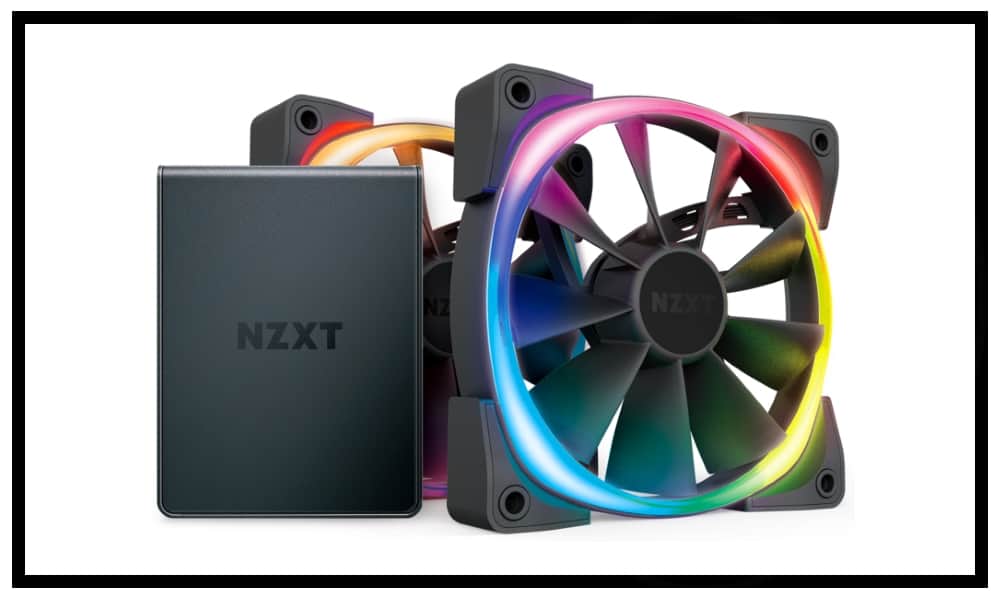
Introduction
Somewhere along the way, PC building went from simply assembling parts to becoming a form of expression. When aesthetics gained importance, we started to see features that included tempered glass, sleeved cables and of course, RGB. When putting RGB into your build, it’s easy to select components that are not compatible and challenging to achieve a unified look. NZXT hopes to solve that problem with its new HUE 2 line of products. The HUE 2 ecosystem consists of many different accessories such as fans, LED strips and cable combs, which all work together harmoniously using NZXT’s CAM software. At the heart of this ecosystem is the NZXT HUE 2 RGB Controller, which you can connect up to 160 LEDs worth of HUE 2 accessories across 4 different channels. NZXT has made it easy to jump into HUE 2 by offering HUE 2 RGB Lighting Kits priced at $74.99 and Aer RGB 2 Start Kits priced at $109.99.
We would like to thanks NZXT for providing us with an HUE 2 RGB Lighting Kit and AER RGB 2 fans for review.
About NZXT

NZXT was founded in 2004 by Johnny Hou and they have been building cases and accessories for PC gamers for over 13 years. Primarily known for their cases, they also develop many cooling accessories such as their Kraken line of GPU and CPU coolers and AER fans. Just recently, NZXT also joined the list of motherboard manufacturers by releasing their first motherboard: the N7 Z370.
Features & Specifications
Hue 2 RGB Light Kit
Notable features:
- 4 Channels with up to 6 accessories per channel or 40 LEDs
- Compatible with Hue 2 eco system accessories
- Fits 2.5” drive bay
- Magnetized
Technical specifications:
| Dimensions | 76 x 100 x 15mm |
| Weight | Product Weight (pkg) – 106.8g |
| Form factor | 2.5” Drive Bay |
| Mounting | Magnet and Screws (included) |
| Control method | NZXT CAM software |
| Connections | Micro-USB Cable – 600mm x1 Molex Power Cable – 300mm x1 Extension Cable – 500mm x1, 300cm x1, 100mm x2 Connection Cable – 500m x4 |
| Input connector | 12V DC via Molex / 2.6A |
| Output channel voltage | 5V DC |
| Output channels | 4 |
| Output LED | 4 LED strips – 10 LEDs per strip |
| LED strip length | 300mm |
| LED strip width | 10mm |
| LED color | RGB |
| LED modes | Preset, Smart, Custom, Audio, Game |
| CAM software | |
| Connections | Micro-USB Cable – 600mm x1 Molex Power Cable – 300mm x1 Extension Cable – 500mm x1, 300cm x1, 100mm x2 Connection Cable – 500m x4 |
| Input connector | 12V DC via Molex / 2.6A |
| Output channel voltage | 5V DC |
| Output channels | 4 |
| Output LED | 4 LED strips – 10 LEDs per strip |
| LED strip length | 300mm |
| LED strip width | 10mm |
| LED color | RGB |
| LED modes | Preset, Smart, Custom, Audio, Game |
AER RGB 2
Notable features:
- 8 LEDs with diffusing ring
- Compatible with HUE 2 lighting system
- Link up to 5 AER RGB 2 fans per HUE 2 channel
Technical specifications:
| FAN SPECIFICATIONS | |
| Dimensions | 120mm – 120x120x26mm 140mm – 120x120x26mm |
| Material(s) | Plastic, rubber, PCB |
| Rated Voltage | 12 V DC |
| Speed | 500-1,500RPM |
| Airflow | 17.48 – 52.44 CFM (120mm) / 30.39-91.19 CFM (140mm) |
| Air Pressure | 0.15 – 1.35mm-H2O (120mm) / 0.17-1.52 mm-H2O (140mm) |
| Noise Level | 22 – 33 dBA |
| Lifetime | 6 Years |
| Bearing | Fluid Dynamic Bearing (FDB) |
| Connector | 4-pin PWM |
| Output Fan Quantity | Up to 5 Aer RGB 2 per HUE 2 channel (40 LEDs) |
| LED SPECIFICATIONS | |
| Output LED | 8 LEDs total |
| LED modes | Preset, Smart, Custom, Audio, Game |
| GENERAL SPECIFICATIONS | |
| Warranty | 2 Years |
Packaging & Unboxing – Lighting Kit
The HUE 2 RGB Lighting Kit is packaged in a white box that has purple accents. The front of the box contains a photo of the HUE 2 RGB Lighting Controller as well as the 4 included LED strips.
On the back of the box, you have a description of the HUE 2 features and capabilities with a shot of a fully built PC with HUE 2 lighting and AER RGB 2 back fan. On the right-hand side, you have the system requirements and specifications list for the HUE 2 RGB Lighting Kit.
Opening the box, reveals the saying “BUILD THE EXTRAORDINARY” on the side of the box. The HUE 2 RGB Lighting Controller is on top, encased in cardboard with only the top visible. Also included on top is the HUE 2 Lighting Kit installation guide.
After unboxed, the entire contents of the HUE 2 RGB Lighting Kit includes:
- HUE 2 RGB Lighting Controller
- 4 x 300mm LED strips
- 4 x 500mm connection cables
- 1 x 500mm extension cable
- 1 x 300mm extension cable
- 2 x 100mm extension cables
- 1 x 600mm micro-USB connection cable
- 1 x 300mm Molex power cable
- 4 x M3 screws
- 4 x Velcro strips
Packaging & Unboxing – AER RGB 2
Like the HUE 2 RGB Lighting Kit, the AER RGB 2 comes in a white box with purple accents throughout. On the front, you have the AER RGB 2 fan with its ring lit up with a rainbow effect. At the bottom of the box you can see it denoted as “FOR HUE 2” indicating it’s a HUE 2 accessory.
Flipping the box over to the back, you are met with descriptions of notable features of the AER RGB 2 as well as how it works within the HUE 2 ecosystem. At the bottom, you have the fan specifications and the system requirements to run the AER RGB 2 fans.
Removing the contents of the package reveals a 2 compartment white box.
The contents of the white box include:
- AER RGB 2 fan
- AER RGB 2 installation guide
- 4 x M5 fan screws
- 1 x 500mm fan-to-fan cable
- 1 x 500mm fan-to accessory cable
- 1 x 500mm fan connection cable
A Closer Look – Lighting Kit
Looking at the bottom of the HUE 2 RGB Light Controller, there are 4 mounting points that mimic a 2.5” drive, so it can be installed in most SSD mounting points in your case. If you don’t wish to mount it in a drive bay, it also includes 4 magnets so that you can place it anywhere in your case with ease. To prevent scratching up your case, NZXT has also included 4 foam pads in each of the 4 corners of the controller. In the center of the unit you also have the model, input voltage/amp and serial number of the HUE 2 RGB Lighting Controller.
On the side, you have 2 of the lighting controller 2 channel outputs as well as some circular venting. Looking towards the back you have the 2 remaining channels, as well as a micro-USB to connect the unit to your USB 2.0 on your motherboard, and a plug for the Molex power cable.
Looking to the other side you have some more venting and, on the front, you have a solid curved surface.
The top of the unit is also solid and includes that ever so subtle branding that NZXT loves to do. You can only see the branding at certain angles.
The included RGB LED strips have a white top with 10 RGB LEDs evenly spaced out. Each strip contains a male and female end so you can daisy-chain them with the included cables.
Looking at the back of the strip, you have a 3M adhesive strip that you can use to attach them to your case. If you have a metal case and wish not to permanently install the strips, NZXT has included 4 magnets in each strip for easy installation.
A Closer Look – AER RGB 2
The AER RGB 2 comes in an all-black design with the diffuse ring being the only thing that is white. Each corner has rubberized pads to help minimize vibration sounds while the fan is running. The fan itself consists of 9 fan blades and has dark gray NZXT letters in the center.
On the back, you have the same rubber pads in the corners and in the center, you have the NZXT branding with a reminder that the AER RGB 2 is for HUE 2 use only.
On the side of the fan you have HUE 2 RGB In/Out ports used to connect it to an HUE 2 Light Controller and also daisy-chain other HUE 2 accessories.
System Build & Installation
The hardware included in this build is:
- Cooler Master MB530P
- ASRock Z370 Tachi Motherboard
- Intel 8700K Processor
- 4 x 4GB TeamGroup T-Force Delta RGB Ram
- EVGA 1070 FTW 8GB GPU
- Cooler Master 212 Hyper Black RGB Cooler
- EVGA 750W P2 PSU
The installation was as easy as NZXT said it would be and I didn’t run into any issues. I really loved the fact that both the LED strips and HUE 2 RGB Light Controller were magnetic as I could easily move them around during the build. I do wish the LED strips had slightly stronger magnets as once I attached the extension cable, it weighed it down a little and sometimes would start to fall over. To remedy this issue, I just have to make sure to secure the extension cables to remove the pressure from the LED strips.
I installed 3 of the LED strips around the front tempered glass panel with them placed on both sides and one on the roof. As you can see, they are nicely tucked away and thanks to the case frame you can’t visually see the strips themselves.
If you take the tempered glass off and tilt the case you can see the installed strip on the side of the case.
Looking to the back of the case, you can see the HUE 2 Lighting Controller is nicely placed beside my SSD. I had originally planned to secure the lighting controller using the back SSD mounts on the MB530P but it was a little too thick and interfered with the tempered glass back panel. Thankfully, I was able to remove the rubber SSD mounts and just make use of the magnets on the back of the HUE 2 RGB Lighting Controller. These magnets were much stronger than the ones on the LED strips and secured the controller nicely on the back of the motherboard tray. My only complaint about the lighting controller would be they went with a Molex connector to power it. I would have liked to see them use the much better SATA connector. I did have 1 more LED strip, so I decided to install it on the roof to add a little bit of light to show off the back of the motherboard.
The AER RGB 2 fans look amazing in the MB530P and I really love how the ring diffuses the light. I know each fan has 8 LEDs, but you really won’t know looking at them since the colors blend together so nicely.
Taking the front panel off, you can get the full view of the AER RGB 2’s and their vibrant color.
Turning off the lights, you can really see how well the HUE 2 RGB LED strips show off your components. The front of the case looks amazing with the AER RGB 2 fans. I really love how the LED strips and fans stay in sync with each other even when on different channels on the controller.
Software
Now that we have installed all of the HUE 2 hardware it’s time to configure it with NZXT’s CAM software. The software itself does a lot more then manage your HUE 2 devices. It also allows you to monitor your system/game performance and the ability to overclock your GPU. For this review we will focus on the lighting configuration tab.
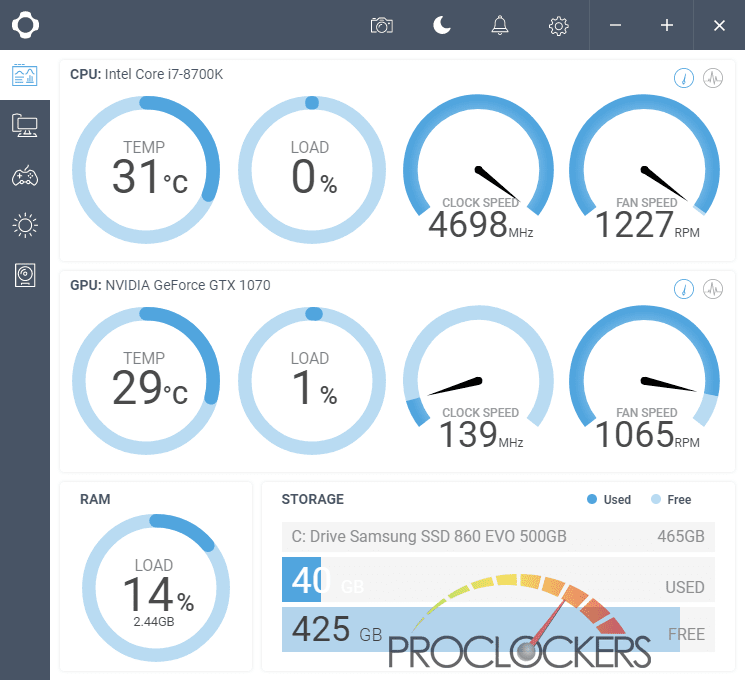
When first clicking the “Lighting” tab, it’s nice to see that the software detected all my HUE 2 devices. As you can see, I have 1 LED strip install in channel 1, 3 x AER RGB 2 fans on channel 2, and 3 more LED strips on channel 3.
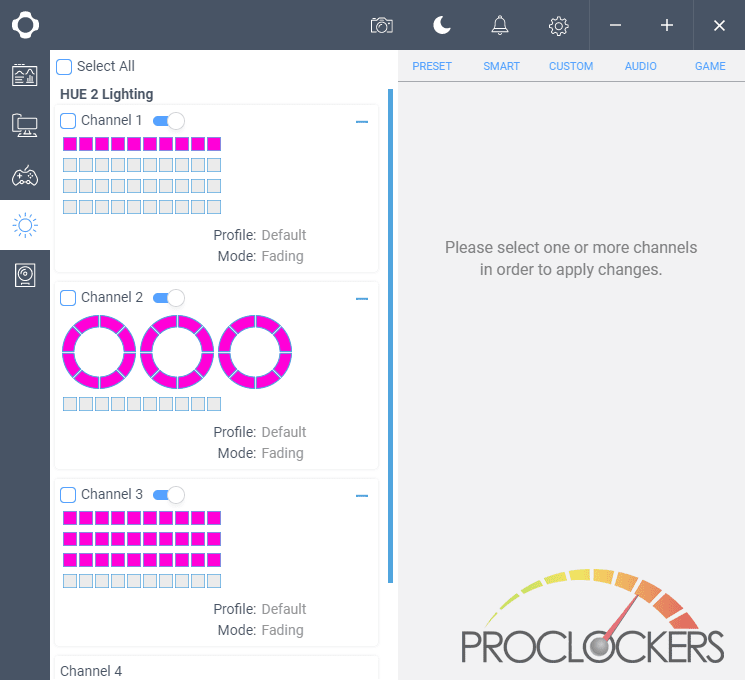
To start configuring each channel, just select the channels you wish to configure in the left-hand column. Once selected, the right column will then appear with all the preconfigured profiles on the Preset tab. There are currently 14 presets you can choose from and each has a different light effect. Here is a general breakdown of the effects:
- Fixed – Solid color
- Breathing – Colors fading in and out
- Fading – Fades colors in and out and blending them during the transition
- Marquee – LED chases around attached LED strips
- Covering Marquee – Like Marquee but the LED stays on when the color moves to the next LED
- Pulse – Pulse the selected color
- Spectrum Wave – RBG Wave going through all colors
- Alternating – Alternates colors each LED between 2 colors
- Wings – 2 chasing LED’s going in opposite directions and bounce off each other.
- Starry Night – Randomly fading in/out LEDs from a base color
- Rainbow Flow – Rainbow effect moving through the LEDs
- Super Rainbow – Rainbow effect that nicely blends through the LEDs
- Rainbow Pulse – Rainbow strobing like effect
- Candle Light – Add a flame effect to the LEDs
- Wings – 2 chasing LED’s going in opposite directions and bounce off each other.
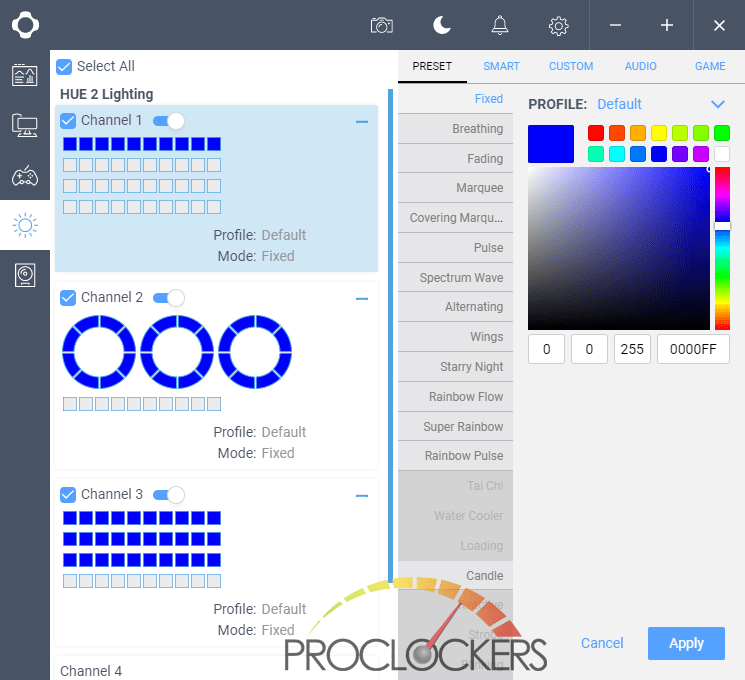
Many of the presets have custom configuration attributes that include:
- One or more color choices
- Speed – Slowest, Slow, Normal, Fast, Fastest
- Direction – Left, Right, Forward, Backwards
- Number of LEDs – Used only in Marquee
The “Fading” effect enables you to add one or more color choice and also change the speed of the fading.
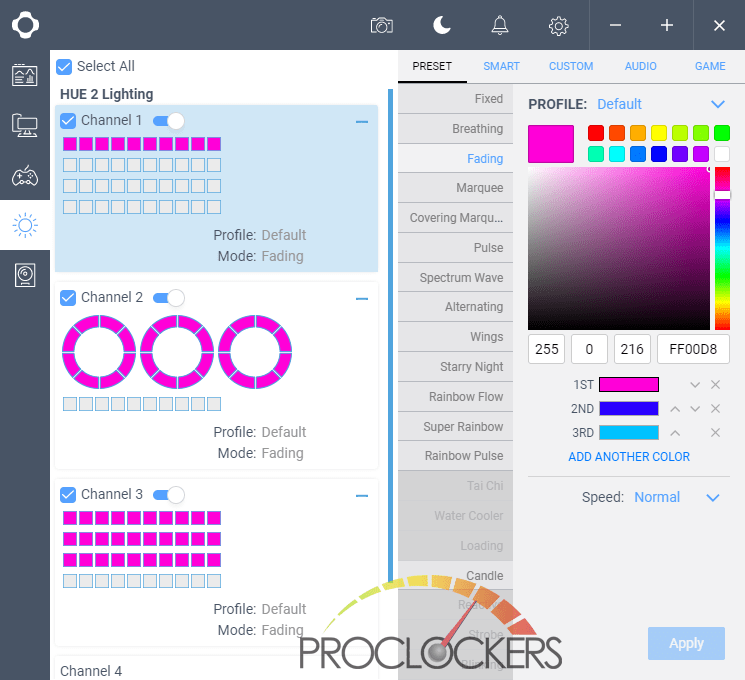
If you wish to shut off a channel, you can by using the toggle next to the channel name. As you can see, we decided to turn off our AER RGB 2 fans. No worries! We quickly turned them back on after screenshotting that photo.
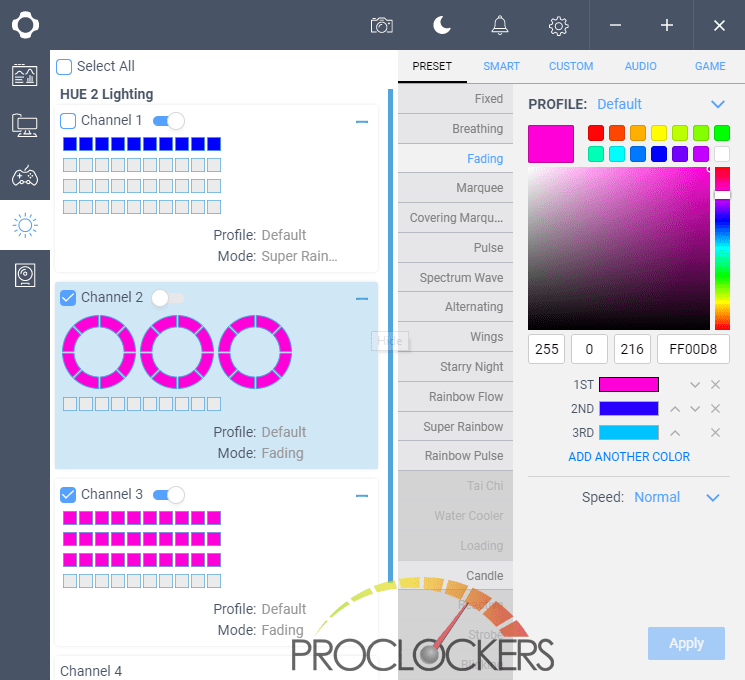
Moving to the “Smart” tab you can configure your LEDs to change color based on your GPU/CPU temperature or the FPS in a given game.
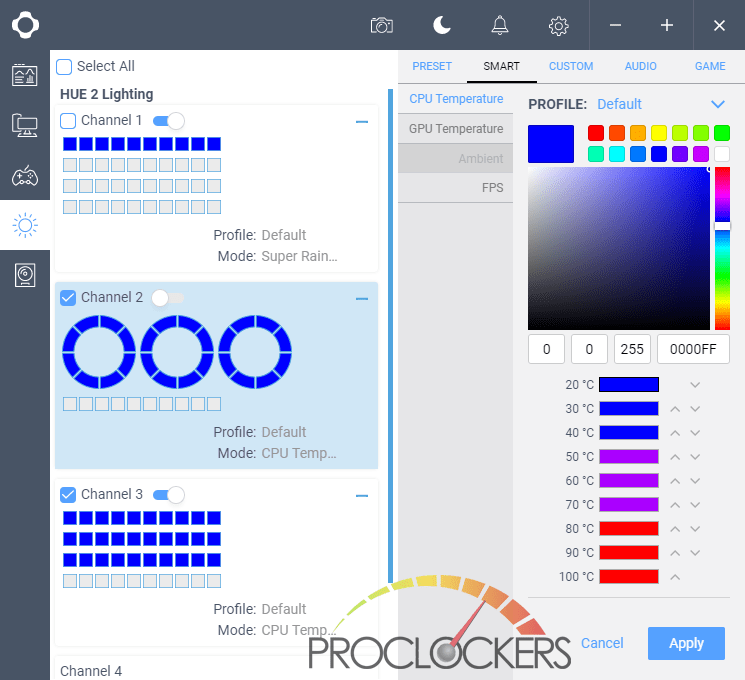
On the custom tab, you can select one of three presets that include Fixed, Fading and Wave. Once selected you can configure individual LEDs by selecting them in the left column and then apply a color to it using the right column.
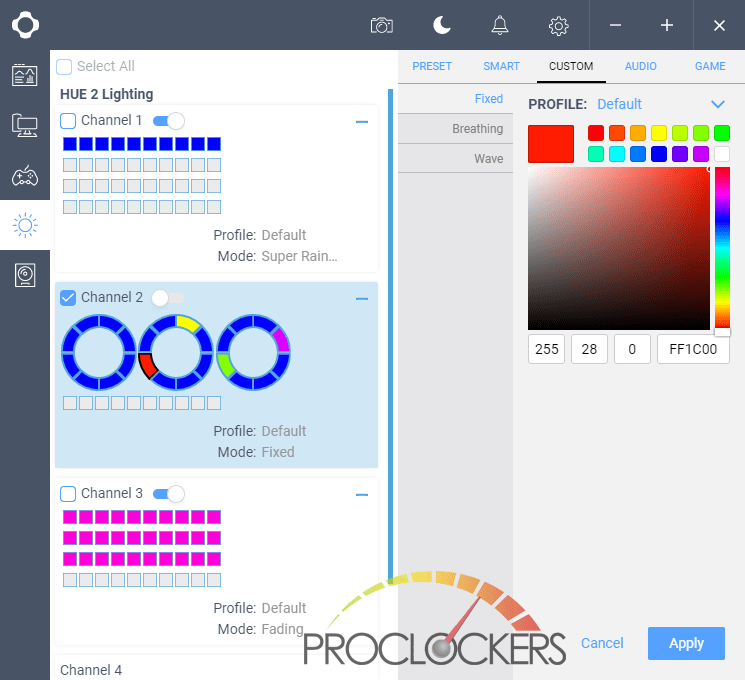
The “Audio” tab allows you to have your HUE 2 lighting change based on sounds. You can configure it to react to the Level, Sync, Bass or Gain.
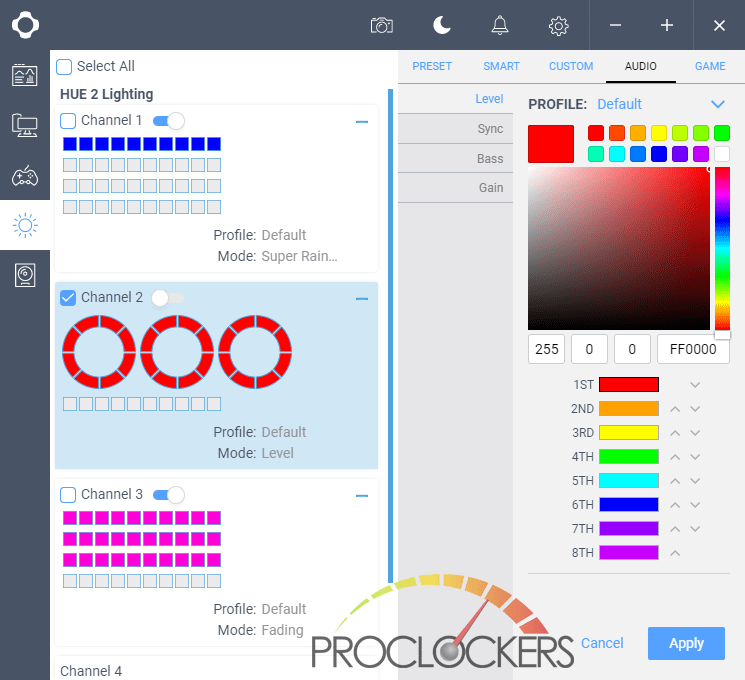
On the last tab, “Game”, you can have HUE 2 react based on the game you are playing. When enabled, it will automatically change the profiles on channels while the game is running. The only game that currently has a lighting profile is CS: GO.
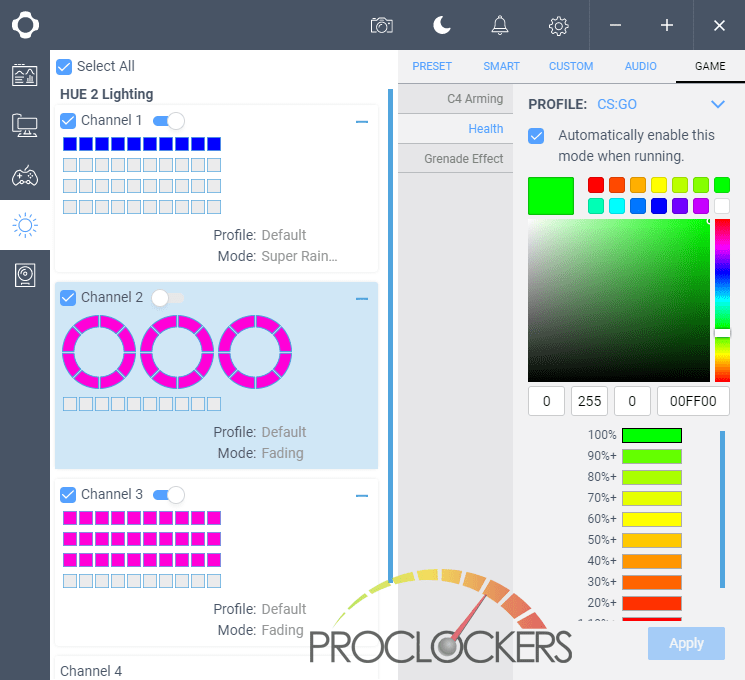
Final Thoughts & Conclusion
This was the first time I have used NZXT’s HUE system and I must say, I’m thoroughly impressed. The LEDs on the inside of my case really show off all of my components with their bright and vivid colors. Equally impressive are the AER RGB 2 fans, which not only look great, but they are also whisper quiet. I really loved that both the LED strips and HUE 2 RGB Lighting controller included magnets on the back. This allowed them to be easily installed and even moved during my build. If you are running a plastic case, NZXT has also included 3M adhesive tape on the back of the LED strips to secure them and the lighting controller can be installed using the SSD mount points or the included Velcro strips. My only complaint about the hardware was the use of the Molex connector to power the controller. It’s well known that Molex are not the greatest connectors, and it would been nice to see SATA used instead.
Moving over to NZXT’s CAM software, much like with the H500i I reviewed previously, it was extremely easy to set up and configure my HUE 2 accessories. CAM comes with plenty of presets out of the box that can really bring your build to the next level. Personally, I went with the “Fading” preset which allowed me to select matching colors that are cycling on my ram to give me a unified look.
Overall, my experience with the new HUE 2 ecosystem was amazing and I’m really enjoying the look I was able to create. It really gave me the brightness and color that I needed to show off my build through the tempered glass of the case. If you’re looking for that extra pop for your build, I highly recommend you check out NZXT’s HUE 2.






